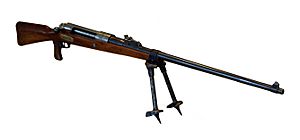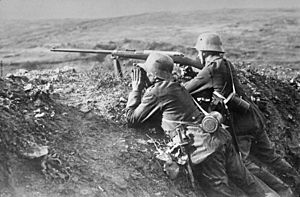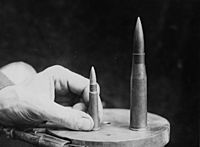Mauser Tankgewehr M1918 facts for kids
Quick facts for kids Mauser Mod. 1918 13.2 mm Tankgewehr |
|
|---|---|

13.2 mm Rifle Anti-Tank at the Musée de l'Armée in Paris
|
|
| Type | Anti-tank rifle, anti-materiel rifle |
| Place of origin | German Empire |
| Service history | |
| In service | 1918–1933 |
| Used by | |
| Wars |
|
| Production history | |
| Manufacturer | Mauser |
| Produced | January 1918 – April 1919 |
| No. built | 16,900 |
| Variants | M1918 shortened Magazine-fed |
| Specifications | |
| Mass | 15.9 kg (35 lb), 18.5 kg (41 lb) loaded with the bipod |
| Length | 169.1 cm (5 ft 7 in) |
| Barrel length | 98.4 cm (3 ft 2.7 in) |
| Crew | two-man crew |
|
|
|
| Cartridge | 13.2 mm TuF (German: Tank und Flieger) |
| Caliber | 13.2 mm (.525 inches) |
| Action | bolt-action |
| Rate of fire | single shot |
| Muzzle velocity | 780 m/s (2,600 ft/s) |
| Effective firing range | 500 m (550 yd) |
| Feed system | manual |
| Sights | 1,000–5,000 m (1,100–5,500 yd) (notched V) |
The Tankgewehr M1918 (which means "Tankgun" in German) was also known as the Mauser 13mm anti-tank rifle or T-Gewehr. It was a special rifle made by Germany during World War I. This rifle was the very first one designed only to destroy armored targets like tanks. It was also the only anti-tank rifle used in World War I. About 16,900 of these powerful rifles were made.
Contents
How the Tankgewehr Was Developed
During World War I, soldiers fought from trenches. This led to the use of armor to protect soldiers. Soon, special bullets that could pierce armor were invented. Both Britain and Germany used powerful hunting rifles, like those for hunting elephants in Africa, to try and stop armored targets.
In September 1916, the British first used armored vehicles called tanks in battle. The French also started using them. By June 1917, the German Army faced the British Mark IV tank. They found that their usual armor-piercing bullets were not strong enough anymore.
This problem led Germany to develop a new, very powerful rifle. It needed to fire heavy, fast bullets to stop tanks. The Mauser Company created the 13mm T-gewehr. They started making many of them in May 1918. The first rifles went to special anti-tank teams. About 14,700 T-Gewehrs were made before the war ended in November 1918. Production stopped in April 1919.
How the Tankgewehr Worked
The T-Gewehr was a single-shot bolt-action rifle. This means you had to load each bullet by hand into the chamber. The rifle had a pistol grip and a bipod (two legs to help it stand). However, it did not have anything to reduce the powerful kickback (recoil) when fired. This could be very hard on the shooter.
The rifle had simple iron sights. These were a front blade and a rear sight that could be adjusted. They were set for distances from 100 to 500 meters. Two soldiers worked together to use the rifle: a gunner and a person to carry the bullets. Both were trained to fire the weapon. Because of the very strong recoil, the rifle was usually fired from a steady position. This was often while lying down or from inside a trench.
Where the Tankgewehr Was Used After the War
After World War I, the United States Army and other Allied Powers tested the T-Gewehr. Poland got some T-Gewehrs during fights near the German border in 1920.
The German army, called the Reichswehr at that time, kept some M1918s in use into the 1930s. Sweden bought some from Germany and called them Pansarvärnsgevär m/21. During the Rif War, rebels in the Rif region got some smuggled Mauser 1918s. They used them against Spanish tanks like the Renault FT and Schneider CA1.
In 1939, a team in the Soviet Union studied the T-Gewehr. They changed it to fire Soviet bullets. A small number were made in July 1941. After the Winter War, Finland bought 100 T-Gewehrs from Great Britain. However, Finland never used them and got rid of them in 1944.
The Special Bullet
The T-Gewehr used a special armour-piercing bullet. It was called the 13.2×92mm cartridge, or "13 mm" for short. This bullet had a hard steel core to help it punch through armor. The "TuF" in its name stood for Tank und Flieger, meaning "tank and aircraft". This bullet was first planned for a new heavy machine gun.
Each bullet weighed about 51.5 grams (795 grains). It left the rifle at a very fast speed of about 785 meters per second (2,575 feet per second).
Here is how much armor the bullet could go through:
| Distance | Armor Penetration (at a straight angle) |
|---|---|
| 100 m (110 yd) | 26 mm (1 in) |
| 200 m (220 yd) | 23.5 mm (0.93 in) |
| 400 m (440 yd) | 21.5 mm (0.85 in) |
| 500 m (550 yd) | 18 mm (0.71 in) |
Where You Can See One Today
You can find examples of the Mauser 1918 anti-tank rifle in several museums around the world:
- In Argentina, at the Museo de Armas in Buenos Aires.
- In Australia, at the Australian War Memorial in Canberra.
- In Austria, at the Museum of Military History, Vienna.
- In Belgium, at the Royal Museum of the Armed Forces and Military History in Brussels.
- In Canada, at the McGill club in Montreal.
- In France, at the Musée de l'Armée in Paris.
- In Germany, at the Museum im Schwedenbau in Oberndorf am Neckar.
- In the United Kingdom, at the Imperial War Museum in London.
- In the United States, at the National World War I Museum and Liberty Memorial in Kansas City.
See also
 In Spanish: Mauser 1918 T-Gewehr para niños
In Spanish: Mauser 1918 T-Gewehr para niños
- Anti-tank rifle
- Boys anti-tank rifle
- Lahti L-39
- Panzerbüchse 39
- PTRD-41
- PTRS-41
- Solothurn S-18/100
- Type 97 automatic cannon
- Wz. 35 anti-tank rifle
- MG 18 TuF



